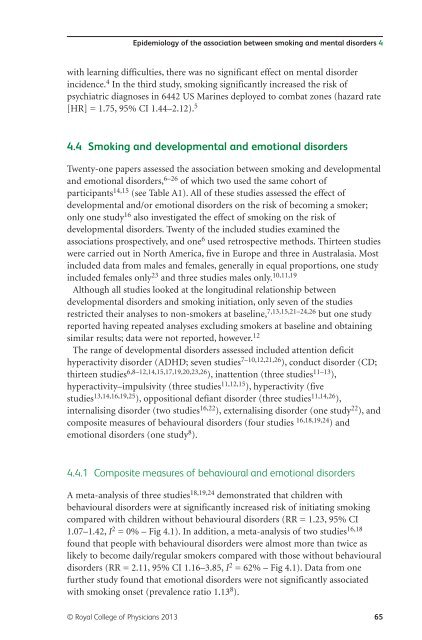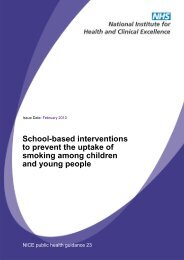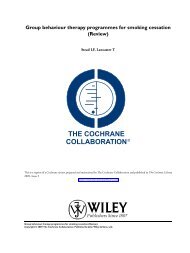Smoking and mental health - NCSCT
Smoking and mental health - NCSCT
Smoking and mental health - NCSCT
Create successful ePaper yourself
Turn your PDF publications into a flip-book with our unique Google optimized e-Paper software.
Epidemiology of the association between smoking <strong>and</strong> <strong>mental</strong> disorders 4<br />
with learning difficulties, there was no significant effect on <strong>mental</strong> disorder<br />
incidence. 4 In the third study, smoking significantly increased the risk of<br />
psychiatric diagnoses in 6442 US Marines deployed to combat zones (hazard rate<br />
[HR] = 1.75, 95% CI 1.44–2.12). 5<br />
4.4 <strong>Smoking</strong> <strong>and</strong> develop<strong>mental</strong> <strong>and</strong> emotional disorders<br />
Twenty-one papers assessed the association between smoking <strong>and</strong> develop<strong>mental</strong><br />
<strong>and</strong> emotional disorders, 6–26 of which two used the same cohort of<br />
participants 14,15 (see Table A1). All of these studies assessed the effect of<br />
develop<strong>mental</strong> <strong>and</strong>/or emotional disorders on the risk of becoming a smoker;<br />
only one study 16 also investigated the effect of smoking on the risk of<br />
develop<strong>mental</strong> disorders. Twenty of the included studies examined the<br />
associations prospectively, <strong>and</strong> one 6 used retrospective methods. Thirteen studies<br />
were carried out in North America, five in Europe <strong>and</strong> three in Australasia. Most<br />
included data from males <strong>and</strong> females, generally in equal proportions, one study<br />
included females only 23 <strong>and</strong> three studies males only. 10,11,19<br />
Although all studies looked at the longitudinal relationship between<br />
develop<strong>mental</strong> disorders <strong>and</strong> smoking initiation, only seven of the studies<br />
restricted their analyses to non-smokers at baseline, 7,13,15,21–24,26 but one study<br />
reported having repeated analyses excluding smokers at baseline <strong>and</strong> obtaining<br />
similar results; data were not reported, however. 12<br />
The range of develop<strong>mental</strong> disorders assessed included attention deficit<br />
hyperactivity disorder (ADHD; seven studies 7–10,12,21,26 ), conduct disorder (CD;<br />
thirteen studies 6,8–12,14,15,17,19,20,23,26 ), inattention (three studies 11–13 ),<br />
hyperactivity–impulsivity (three studies 11,12,15 ), hyperactivity (five<br />
studies 13,14,16,19,25 ), oppositional defiant disorder (three studies 11,14,26 ),<br />
internalising disorder (two studies 16,22 ), externalising disorder (one study 22 ), <strong>and</strong><br />
composite measures of behavioural disorders (four studies 16,18,19,24 ) <strong>and</strong><br />
emotional disorders (one study 8 ).<br />
4.4.1 Composite measures of behavioural <strong>and</strong> emotional disorders<br />
A meta-analysis of three studies 18,19,24 demonstrated that children with<br />
behavioural disorders were at significantly increased risk of initiating smoking<br />
compared with children without behavioural disorders (RR = 1.23, 95% CI<br />
1.07–1.42, I 2 = 0% – Fig 4.1). In addition, a meta-analysis of two studies 16,18<br />
found that people with behavioural disorders were almost more than twice as<br />
likely to become daily/regular smokers compared with those without behavioural<br />
disorders (RR = 2.11, 95% CI 1.16–3.85, I 2 = 62% – Fig 4.1). Data from one<br />
further study found that emotional disorders were not significantly associated<br />
with smoking onset (prevalence ratio 1.13 8 ).<br />
© Royal College of Physicians 2013 65














